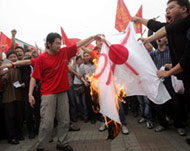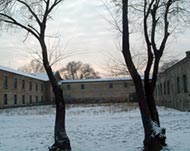Bringing Japan’s biological war to light
The latest round of anti-Japanese demonstrations in China may havestarted to wind down, but one woman’s campaign against Japan’s wartimelegacy continues.

“I do not see myself as a political activist,” Chinese lawyer Wang Xuan says. Representing Chinese victims of Japan’s biological warfare research experiments, Wang’s work is as political as it gets.
With bilateral relations between the two countries at their worst since they were established in 1972, Wang is trying hard to build support for her case – scheduled for the later half of this year – in the Japanese courts.
But the rejection by a Tokyo judge of a similar case brought by victims of Japan’s wartime actions on 19 April has dampened her hopes.
“Given this ruling and the current diplomatic situation, it is quite possible our case will also be thrown out,” Wang said.
Little publicity
A linguist by training, 52-year-old Wang first took notice of the case in the early 1990s, soon after reading how some Chinese farmers were planning to sue Japan for testing the effects of the bubonic plague on their village.
 |
|
Japan’s atrocities in China were |
It was not just that they were her compatriots that drew her attention.
They were from her hometown of Yiwu, in the coastal province of Zhejiang, and as she was to find out later, her own uncle had been one of the victims of the Japanese tests.
Compared to the Holocaust, Japan’s atrocities in China were until recently unknown to the Western public.
The 1997 book Rape of Nanking by the late Iris Chang changed this.
Translated into 13 languages, the book was received as an eye-opener into what had happened.
Chang documented for a Western audience how Japanese soldiers raped and killed Chinese residents of the central Chinese city of Nanjing. Several hundred thousand civilians were killed in a period of four months.
Nanjing was previously known as Nanking to the West.
Japan’s biological warfare experiments are, however, less well documented. Initiated under a signed order from the Japanese emperor – a factor Wang believes explains why, to this day, Japan has not fully opened its archives on the subject – Japan established a series of chemical and biological weapon research centres across China.
Human guinea pigs
Japanese scientists conducted experiments using the local population as human guinea pigs, she says.
Typically, whole villages were exposed to various pathogens, such as the bubonic plague or cholera, and then monitored for effects.
Documents seized after the war ended show that some people – referred to as “monkeys” by the scientists – were even taken to the centres and vivisected without anaesthetic so scientists could see the effects of the diseases on the internal organs.
 |
|
Unit 731 was said to have carried |
At the clinically named Unit 731 in the northeast Chinese city of Harbin, several thousand people – some prisoners of war, others civilians – were kept inside the centre and injected with pathogens directly.
Others were tied up outside in the freezing winter temperatures so scientists could see the body’s reaction to frostbite.
In one town that Wang is working with in Zhejiang province, six different germs were tested on the civilian population between 1940 and 1942.
Using testimony from Japanese soldiers, and records from the local centre for disease control, Wang has shown that over 300,000 people were affected by the tests, which included plague. Some 50,000 died.
Scientists also researched how best to deploy these potential weapons. At Unit 731, now a museum, records show how the military perfected bombs that could securely carry germs, or their animal hosts, and not destroy them upon impact.
Historians’ estimates say as many as 300,000 people died as a result of these tests, although as most of the relevant documents were either burnt or taken back to Japan, the actual figure remains unknown.
Japanese journalists
This all came to light, however, not at the end of World War II, when China was once again racked by internal conflict, but in the early 1980s when Japanese journalists began investigating stories that military scientists had been experimenting on human subjects.
|
“Theoretically speaking, there is no government mechanism that recognises how such programmes were conducted, but on the other hand, no Japanese politician would say that these programmes did not exist” Ide Kenji, spokesman, |
What they discovered was that a number of respected doctors then working in Japanese hospitals and pharmaceutical companies had made a deal with the US military at the end of the war.
In exchange for the research data, the scientists won immunity from the war trials, and were able – temporarily, it turned out – to reintegrate into an unsuspecting society.
Enter Wang, who after meeting with survivors of the tests, began petitioning the Chinese government in the early 1990s to let her take her clients’ claims for compensation to the Japanese courts.
It was to be a long journey.
Supportive of the recent protests, but critical of the police’s failure to curb anti-Japan violence in Chinese cities, Wang says in pursuing this case it has not just been the Japanese government she has had to fight, but her own as well.
No government help
In 1972, renouncing all demands for state-to-state war reparations as one of the conditions for establishing diplomatic relations, the Chinese government was not at all keen on the idea of Wang reopening old wounds.
“If I was being charitable I would say the Chinese government did not understand the idea of an individual pursuing such a case,” Wang says.
“At that time, the rights of the individual were still new to China. However, I also heard that given the economic relationship between the two countries, and that as many officials were privately benefiting from it, there were people who did not want me to upset the status quo.”
|
“We have been pushing for years for our government to conduct more open research into the war but they won’t. Until recently, Chinese newspapers would not even report on our case” Lawyer Wang Xuan |
It was only because the government realised it could not be seen by the public to be blocking such a sensitive case that Wang won permission.
Still prohibited from even forming a pressure group on the issue, Wang has relied on the help of Japanese peace activists and donations from Chinese individuals. Asking for help from the Chinese authorities, she says, would be futile.
“We have been pushing for years for our government to conduct more open research into the war but they won’t. Until recently, Chinese newspapers would not even report on our case.”
Difficulties and intricacies
That little of this is known to the protesters at the recent demonstrations speaks volumes about how the government has obscured the realities of Japan-China relations.
One example has been China’s use of maps.
In the 1950s, several maps published showed the now disputed Diaoyu Islands (Senkaku in Japanese) as belonging to Japan, indicating, at the very least, official indifference to the barren rocks’ ownership.
After suggestions in 1969 that there could be oil and gas in the surrounding waters, Beijing’s position on the island’s ownership hardened, and the demarcation line was shifted in China’s favour.
Another example is statistics.
 |
|
Lawyer Wang Xuan wants most |
At the end of World War II, the Chinese government said 1.75 million Chinese had died. In 1949, it gave a total number of 9.32 million, and then in 1995, this increased to 35 million. One foreign journalist told Aljazeera.net that he remembered the number jumping by five million in a week during the mid 1990s.
Statisticians say the most recent figure takes into account more detailed analysis of civilian casualties but with China’s reputation for distorting figures, critics have dismissed it as politically motivated.
Tokyo taciturn
Japan, however, has never fully come to terms with its wartime experiments. On the issue of biological weapon research, the government still remains tight-lipped.
“Theoretically speaking, there is no government mechanism that recognises how such programmes were conducted, but on the other hand, no Japanese politician would say that these programmes did not exist,” Ide Kenji, Japanese embassy spokesman, told Aljazeera.net.
This has translated into problems for Wang in the courts.
When her case was heard in 2002, Japanese courts ruled that although biological weapons had been used, the individual is not a recognised entity under international law and so foreign nationals could not sue for war damages.
In addition, says Wang, judges appointed to hear her case keep being changed. She suspects it is so they do not become swayed by the emotionally powerful testimonies.
What is needed most of all, says Wang, is an airing of historical facts.
This week’s suggestion by the Japanese foreign minister to establish a joint committee to explore the war might go some way to achieving this.
This way, in between all the diplomatic jostling and economic cooperation, the real victims of the war might still be remembered.